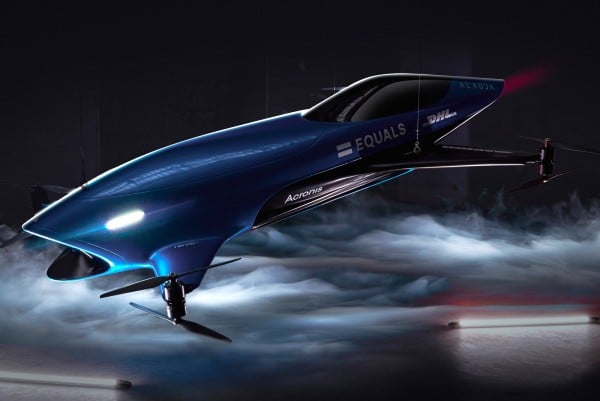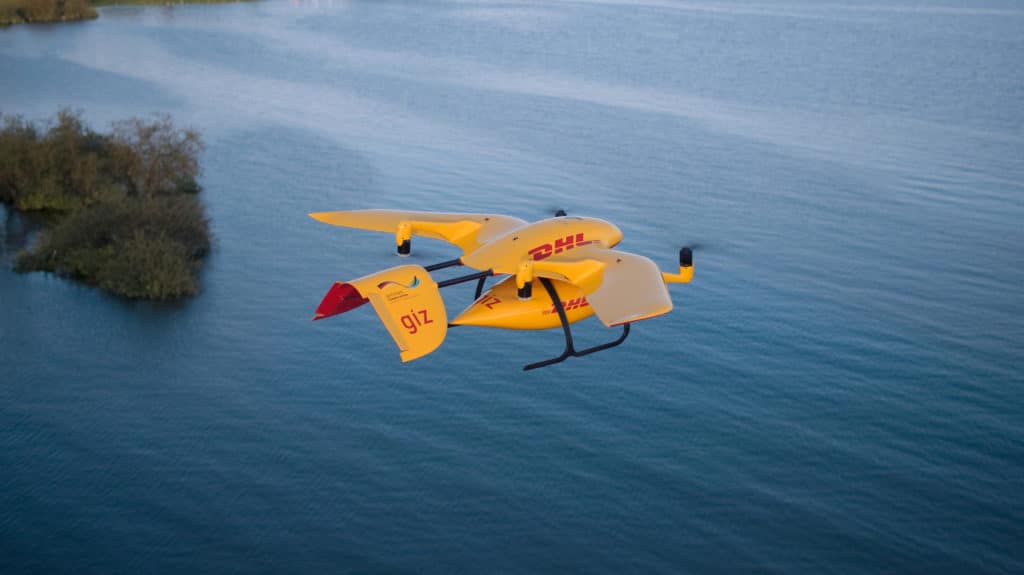Drones have come a long way from carrying small packages. In fact, drones have advanced to the point where some can even lift a person. The idea of drones carrying people was once illegal, but now it’s becoming more common with large companies shifting their focus to this endeavor.
This article will explore the exciting possibilities of drones lifting people, including the creative ways that people have already used drones for this purpose. Additionally, we’ll delve into the future of Urban Air Mobility (UAM), which is an entire sector of the drone industry dedicated to this innovative technology. From aircraft engineering to regulatory molding, this field is rapidly evolving and promises to revolutionize the way we travel.
First, here’s a tl;dr for the people in the back.
Can A Drone Lift A Person?
Drones are capable of lifting a person off the ground with their thrust, especially medium to large ones. However, it is important to note that carrying a person safely requires a drone specifically designed for that purpose. Notably, companies such as Uber and Wisk are presently constructing drones to carry multiple people. This trend is referred to as Urban Air Mobility, or UAM, and is gaining popularity.
I’ll dive into my favourite companies who are taking this technology in cool directions. But first, let’s take a look at the fun experiments people have undertaken over the years.
Online Drone Projects
Snowboarding via Drone

Here’s a throwback to 2016 where Casey Neistat is being pulled by drone while snowboarding. I was still new to the drone industry at that time, and this was my first encounter with the idea of a drone lifting a human being.
Initially he is being pulled along the ground by an octocopter which is cool, but nothing too impressive by today’s standards. However, as the video progresses we begin to see the drone lift his entire body several meters into the air.
By the end of the video, we see this attempted multiple times and for a long duration. Quite an impressive feat, especially for 2016.
Overall a really cool project and build, and the first thing I think of every time someone asks me if drones can carry a person.
Skateboarding via Drone

Another similar idea, however this time via an FPV drone. This video is actually quite recent but doesn’t have the wow factor of Casey’s video mentioned previously.
Drew from Rotor Riot is being pulled along on the concrete by an FPV drone made of 16 motors! Although he is not necessarily lifted into the air, he is being pulled along concrete which has much higher surface friction than ice/snow.
Without much room to maneuver in the parking lot, their efforts are quite limited. Given enough space, I’d be curious what could happen. I still think this is a mentionable addition because of the FPV aspect, and the custom 16 motor setup.
Fishing via Drone
Now this is the crème de la crème of a homemade drone, lifting a person into the air! An Australian bloke in a chair, strapped to a drone, fishing and drinking beer.
I have conflicting feelings about this one. As a professional drone pilot, I cringe at the safety concerns involved in an impromptu set-up like this.
The take-off weight would place the operation in the medium to large categories, which is heavily regulated. Although, I don’t doubt the people involved are quite experienced to have achieved such a feat.
However, as an Australian… I think this is amazing. I don’t know if I’d find this relaxing, but it definitely would be exhilarating. The beer tops it off, a good old Victoria Bitter (VB) stubby. A hard earned thirst needs a big cold beer.
Between us, if my remote pilot license wasn’t at risk I’d love to do something similar.
Check out the video:
Urban Air Mobility (UAM)
Urban Air Mobility is an industry looking to make air travel a daily means of transport. Both manned and unmanned aircraft systems will occupy this space.
These drones are more akin to commercial passenger aircraft than the typical off-the-shelf drones from your local electronics store.
The main difference between UAM drones and other passenger aircraft, is the lack of a pilot on board. These drones are intended to be completely autonomous, navigating the airspace using a system called Unmanned Aircraft System Traffic Management (UTM).
Wisk

A company I hear in my working circles often is Wisk. This was mainly because they are operating in the country next door. Wisk and the New Zealand government are working in collaboration to deliver the world’s first passenger-transport trial.
Wisk is a joint venture between Kitty Hawk Corporation (sinced closed down) which operates in the drone sector, and The Boeing Company from traditional aviation.
They are looking to offer a flying taxi service to the masses which can apparently be ordered via an app on your phone.
Their aircraft Cora and is an Electric Vertical Take-off and Landing (eVTOL) design that can carry 2 people at a time.
As of late 2020, Wisk had partnered up with NASA in order to make accelerated progress in the certification requirements and processes for future UAM projects.
With NASAs technical expertise in autonomy and aerospace, I think Wisk might just be one of the first companies to realistically bring this technology to the public.
Uber Elevate
Uber shouldn’t need any introduction but their venture into autonomous aircraft might be news to you.
Although Uber has been working on this project for 5 years now, their main focus has been working with regulators and technology companies to lay the foundation for a lot of today’s UAM environment.
Recently, they sold Uber Elevate to Joby Aviation which is an aerospace company that has been developing their own eVTOL passenger aircraft. The company had intentions of bringing this technology to market as early as 2023 (an optimistic estimate looking back).
The aircraft is all electric, capable of flying 150 miles (240km) in a single charge. It has a top speed of 200mph (320km/h) and can carry 4 passengers and a pilot.
For the moment their intentions are to remain manned with a pilot which does not make this a drone. However, I suspect as their self-driving cars become reliable that they may make a shift into fully autonomous passenger aircraft as well.
It only makes sense to go autonomous to reduce costs, and as the technology becomes more commonplace and easily implemented, eventually it should be a necessity from a financial standpoint.
Volocopter
Volocopter is in the same boat as Uber Elevate whereby their current technology is intended to be manned with a pilot onboard their aircraft.
However their cofounder has stated that within a number of years, they will begin testing autonomous options to their technology.
It appears however, that they do have an autonomous aircraft model already designed but information is very scarce.
Volocopter has conducted test flights in Singapore, Stuttgart and Dubai. Their aircraft, the Volocopter 2X can travel approximately 70mph (110km/h) with an operational range of just over 20 miles (35km).
It can carry a maximum of 2 passengers and their luggage, up to 200kg.
Interestingly enough, Volocopter has already begun selling tickets in anticipation of their first commercial flights estimated for 2023-2024. However they have yet to make any concrete decisions about the details such as location.
Airspeeder

Now here is an awesome example of flying transportation for the future! Airspeeder is essentially Star Wars-esque pod racing brought to life.
Unlike Uber and Volocopter, who have the intentions of transitioning from manned flight to unmanned flight, Airspeeder wants to do the reverse.
Airspeeder is currently testing unmanned versions of their aircraft to ensure that it operates safely. However, in the future they intend to transition to manning their aircraft.
They are aiming to create the equivalent Formula 1 car, for the air, with a person in the driver’s seat, or cockpit? Take a FPV racing drone, enlarge it, and throw a person in there, it’s really that wild.
They are currently on the MK.4 model of their aircraft which goes from 0-60mph (100km/h) in 2.3 seconds! It’s airframe is in a H pattern with top and bottom mounted rotors on each arm and weighs in just under 900 pounds (400kg).
Airspeeder is actually hoping to debut their racing creation in 2022! We won’t be waiting too long to see how this one pans out. I personally can’t wait! Maybe I’m biased as this company operates in Australia, and I’ve known about them for some time now.
Regardless, if their dreams of creating a worldwide sport never come to fruition, I’d be happy to see how their technology influences the drone landscape and what other possible applications might be possible.
Final Thoughts
Ultimately, I’m super excited to see where this technology can go in the next few years. I’m sure by 2030, we’ll consider a lot of this information mundane just how we look at smartphones today.
There is still a lot of testing to be done, and most importantly there is still a lot of safety concerns to address. I’m glad that there are some big name companies involved in this evolution of transport because what it’s really going to take, is a lot of cash money to get this off the ground (pun-intended).
Due to the nature of the technology, even if the technology became readily available and affordable, it may take even longer for it to be adopted by the public.
We’re still only getting used to small drones in our airspace, so I can’t imagine that these large form of drones will be accepted anywhere near as fast.
Some people find the small drones we have today invasive, and others find them noisy.
The future looks crazy, but today looked the same in the eyes of yesterday. Keep an eye on the skys. You might just be cruising around there tomorrow. Hope you enjoyed the read! Cheers
Now you know how much a large drone can carry, check out my other article to find out How Much Weight Can A Small Drone Carry?



